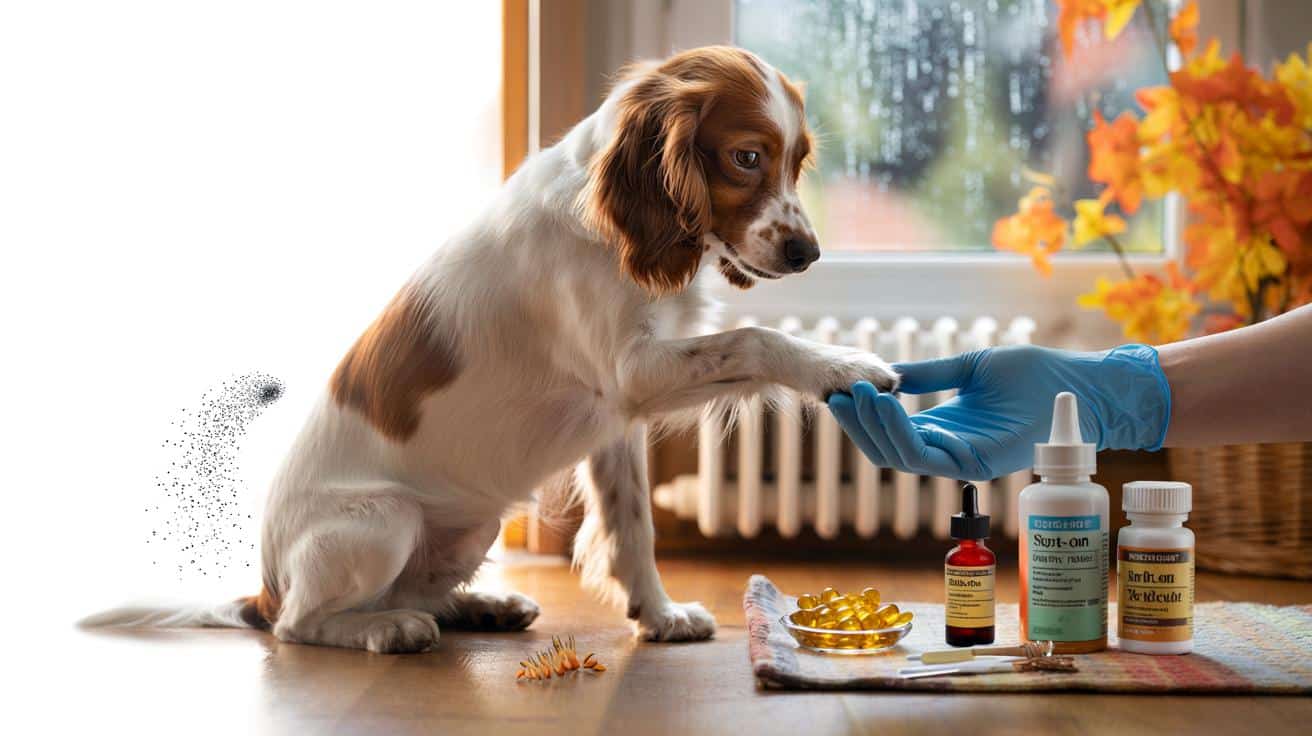Your dog’s scratching gets louder the minute the heating clicks on and the leaves mat down on wet pavements. It’s not random. Autumn flips a handful of switches that turn minor irritations into a full-blown itch cycle. If you’re hearing that collar jingle at 2am, you’re not imagining it.
Your dog pauses mid-tail-wag and digs at the side of their neck, then worries a paw, then another. The radiator hums, the windows fog, and the itch seems to gather its own weather system. *I can still hear the jingle of Buddy’s tag as he digs at his neck.* You watch, you wince, you reach for the brush that didn’t help yesterday either. We’ve all had that moment when the itching becomes the soundtrack of the season. Your dog looks at you, asking a question you can’t quite answer. Maybe the season is answering for them. And not gently. A small clue hides in plain sight.
Three autumn culprits behind the itch
When the nights draw in, real life moves indoors. So do fleas. Eggs laid in summer hatch happily in warm homes, and central heating turns carpets into nurseries. Outside, hedgerows host harvest mites, those tiny orange specks that love ankles, toes and bellies. Add leaf mould and the city’s fine mist of spores, and that casual scratch turns rhythmic, then relentless. Add woolly jumpers and close-fitting harnesses that rub. The season layers on triggers like a scarf you didn’t ask for.
Take Mabel, a gentle, spaniel-eared sweetheart from a terraced street in Leeds. She sailed through July, then came September and the school run—new pavements, new parks, same favourite hedges. Within a week she’d chewed a hotspot on her tail base, and by the second she’d pinked up around the paws. Her vet lifted her tail, found peppery flea dirt, and a constellation of tiny orange mites between the toes. No judgement, no drama. Just two autumn stowaways and a dog who’d had enough.
The pattern makes sense once you see it. Flea allergy dermatitis pivots on a single bite, so even “I never see fleas” dogs can be tormented. Environmental allergies don’t disappear with the last grass pollen; moulds take over the stage, and dust mites bloom in cosy rooms. Dry indoor air cracks the skin barrier, and overenthusiastic bathing strips away oils. Put those together and nerves in the skin fire more easily, so scratching trains the body to itch even more. The loop tightens, then feeds itself.
Omega-3s that actually help — and what your vet may prescribe
Start with the barrier. Choose an omega-3 that lists combined EPA and DHA in milligrams, not just “fish oil”. Look for triglyceride-form oils from small fish (anchovy, sardine) or algae oil if you prefer plant-based, aiming for a daily total that often sits around 50–100 mg per kg of your dog’s bodyweight. Add it to food to blunt any fishy burps, and give it time—skin takes weeks to turn over. Pair with lukewarm rinses and a simple, fragrance-free emollient spray on itchy zones. Small, steady steps change the skin’s mood.
Let’s be honest: nobody really does that every day. So pick a routine you’ll actually keep. Swap long baths for quick paw-wipes after walks—especially between toes where harvest mites party. Choose a vet-grade flea and mite control from the isoxazoline family; these are prescription-only for a reason and tend to shut down the itch chain fast. If your dog has red bumps, odour, or greasy skin, ask your vet about a medicated shampoo with oatmeal or chlorhexidine and give it real contact time. Two minutes feels long in a bathroom. It matters.
Vets have more levers to pull when the itch runs the show. Short courses of anti-itch medicine like oclacitinib or **lokivetmab** injections can break the spiral, while antibiotics or antifungals tackle any infection that snuck in through scratch-made doorways. For food-responsive dogs, a strict elimination diet brings clarity you can’t buy in a bottle. Spare yourself the guilt and ask for a plan you can live with.
“We don’t need heroics,” a calm vet told me on a wet Tuesday. “We need the two or three things that actually move the needle, done well and done consistently.”
- Think seasonally — step up parasite control and paw care from late August to November.
- Pick omega-3s with clear EPA/DHA numbers and third-party testing (IFOS or similar).
- Keep baths brief, tepid, and followed by moisturiser; long hot baths sabotage the barrier.
- Watch for harvest mites on orange-stained toes and belly lines after meadow walks.
- Call the vet early if you see hair loss, scabs, or your dog loses sleep from itching.
What to carry into the colder months
Autumn asks for a different rhythm, not a panic. A little more oil in the bowl, a little less heat in the bath, a parasite plan that respects how fast fleas hatch in warm rooms, and a vet on side before things snowball. Keep a simple diary of flare-ups and walks; you’ll spot patterns before they bite back. If your dog sleeps through the night and greets the morning without paw-chewing, that’s your north star.
| Key points | Detail | Reader benefit |
|---|---|---|
| Three common causes | Fleas/harvest mites, environmental mould/dust mites, dry barrier from heating and bathing | Know where to look and what to change first |
| Best omega-3s | EPA/DHA listed by mg, triglyceride form, small fish or algae, 50–100 mg/kg daily | Choose supplements that actually influence skin inflammation |
| Vet treatments this autumn | Isoxazolines for parasites, oclacitinib or **Cytopoint** for itch, medicated shampoos, infection control | Understand the toolkit and when to book an appointment |
FAQ :
- Why does my dog scratch more in autumn?Warm homes hatch flea eggs, harvest mites thrive in fields, and indoor air dries the skin barrier. Mould and dust mites take over from summer pollens, so the itch shifts, not ends.
- Which omega-3 is best for dogs with itchy skin?Look for products that name EPA and DHA amounts, ideally in triglyceride form. Fish oils from anchovy/sardine or high-quality algae oils are solid picks, with third-party purity testing.
- How long before omega-3s make a difference?Skin turnover needs weeks. Many dogs show calmer skin in 4–8 weeks, faster if you pair oils with parasite control and gentle skincare.
- Can I use human fish oil for my dog?Sometimes, yes—but dosing and vitamin D levels vary, and oxidation is a risk. Use veterinary-labelled oils or discuss a reputable human brand and dose with your vet.
- When should I see a vet?Any bleeding, bad smell, hair loss, restlessness at night, or chewing that won’t stop deserves a prompt visit. **If you spot orange specks on toes after field walks or flea dirt at the tail base, see your vet fast.**








